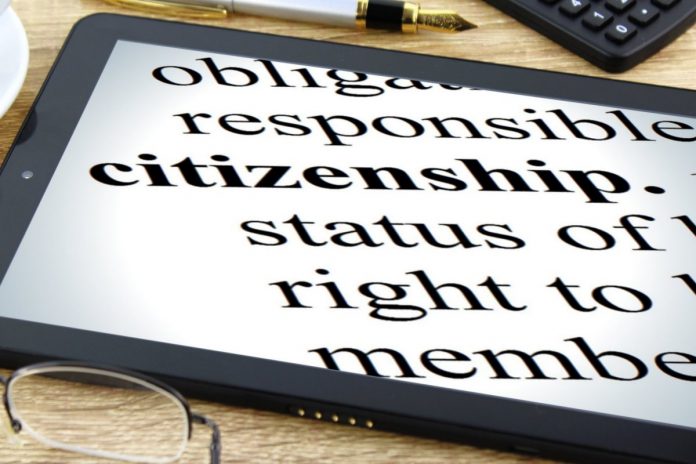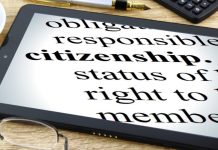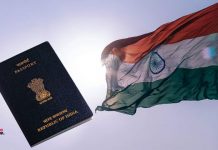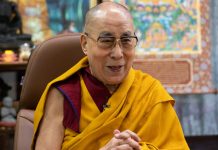This article is written by J Jerusha Melanie, a student of SRM School of Law, Tamil Nadu. This article presents an exhaustive elucidation of the history and the impact of the Declaration of Rights of Man and of the Citizen, 1789.
It has been published by Rachit Garg.
Table of Contents
Introduction
One can not emphasize enough how important the legal recognition of civil rights is to the citizens. It provides a way to resolve disputes between two or more individuals or legal entities. The recognition takes place by the promulgation of legislation. The Declaration of the Rights of Man and of the Citizen of 1789 is one such legislation in France. It laid the foundation for the recognition of the basic rights of the Third Estate, which we shall discuss next.
One of the first ever documents on human civil rights, the Déclaration des droits de l’homme et du citoyen de 1789 was drafted by the National Constituent Assembly. It has seventeen Articles, the most fundamental of which is Article 1, which states that “all men born and remain free and equal in rights”. Let’s try to understand the Declaration of the Rights of Man and of the Citizen, 1789.
History of the Declaration of the Rights of Man and of the Citizen
Like almost all revolutionary laws, the Declaration of the Rights of Man and of the Citizen of 1789 (hereinafter called ‘the Declaration’) also has a remarkable historical background. It was an attempt by the commoners of 18th century France to get equal rights and liberties and abolish the extremely prejudiced Estate System or Ancien Régime. To understand the Declaration, it is crucial to know the reasons that led to its making. Let’s begin by apprehending the social structure of France in the 1780s.
The Estate System
In the 1780s, the French population was categorized into three groups or estates, depending upon their social position during birth. The first estate consisted of the members of the Roman Catholic clergy. It included the monks, bishops, priests, nuns, and other religious characters in France. The clergy was further tiered depending on their position in the church. For instance, the bishops were considered members of higher positions within the clergy. The entire first estate made up just a minuscule fraction of 0.5 % of the French population.
The second estate consisted of the French nobility, making up roughly 2% of the French population. It consisted of the most powerful members of the military and government. The second estate owned around 20% of the French land.
The huge chunk of around 98% of the French population represented the third estate. It consisted of the commoners, including lawyers, merchants, peasants, labourers, etc. On the pinnacle of the estate system sat the French monarch, Louis XVI.
The Estate System was highly unjust and discriminatory. While the third estate profitlessly served them, the first and second estates enjoyed the fruits of the third estate’s labour. The first and second estates were forced to pay almost half their income as taxes, while the rich and lofty first estate was exempted from paying any taxes. The clergy collected tithes (one-tenth of the annual produce or earnings) from the third estate in the name church. Though it owned nearly 6% of the French land, the church was exempted from paying land taxes. The 18th century France literally ran on the third estate’s grinds. The elite estates were symbols of superiority, honour, and lavish living, while the third estate lived in poverty and food insecurity. The members of the third estate were always looked down upon by the elite estates.
Emergence of the Bourgeoisie
Meanwhile, the 1780s saw a rise in the bourgeoisie (the comparatively well-off members of the third estate). They were the middle-class people of the French population. They were generally the rich merchants, bankers, lawyers, industrialists, etc. The mentality and ideology of the bourgeoisie were quite different from that of the rest of the third estate. While the other members of the third estate accepted their bitter reality and endured the prejudice, the bourgeoisie desired to abolish the estate system and climb up the ladder of social status. They aspired for social and economic equity. This gave birth to a group of revolutionary third estate members who were ready opponents of the first and second estates and their atrocities.
Rise of the Age of Enlightenment
The Age of Enlightenment was a notable period of intellectual values in European history. It debatably prolonged from 1715 to the beginning of the French Revolution in 1789. It was during this period a range of philosophers arose to question the existing philosophical and religious dogmas(ideologies) and introduce new reasonable ideas.
Francis Bacon and René Descartes were the pallbearers of the Age of Enlightenment. Some of the other Enlightenment philosophers were Thomas Hobbes, David Hume, Immanuel Kant, John Locke, Baron de Montesquieu, Jean-Jacques Rousseau, Hugo Grotius, etc. They stressed the importance of scientific reasoning and condemned age-old religious orthodoxy. For instance, John Locke, Montesquieu, and Jean-Jacques Rousseau advocated the concept of ‘separation of powers’ to avoid the concentration of powers on one hand and the arbitrary actions that it may give rise to.
Financial crisis
18th century France was dotted with various continuous ill-managed military endeavours which ruined its financial stability to a great extent. The ambitious Seven Years’ War (1756-1763) that was fought predominantly between France and Great Britain only left a hole in the French treasury. France, led by King Louis XV, not only lost the war but also ended up sabotaging its naval possessions.
To avenge the loss, France took a bold step and resolved to build a bigger navy. The number of masts increased from 1,576 in 1763 to 4,341 in 1766. Nevertheless, the move only drained the treasury deeper. Further, the involvement of France in the American Revolutionary War (1775-1783) (also known as the American War of Independence) left it financially devastated.
Food crisis
The eruption of Iceland’s Laki volcano in 1783 had a serious impact on France’s weather conditions. The eruption produced 8 million tons of fluorine and 10 million tons of sulfur dioxide, which resulted in a series of extreme droughts and summer storms in France. This made France go through poor harvests combined with harsh winters in 1787-1788. Ultimately, the price of flour drastically inflated, and so did the cost of bread (the staple food for most French).
The inflation took a massive toll on the third estate’s daily survival. Such was the situation that in 1788, an unskilled Parisian labourer would spend about half of his daily wages on bread; the situation worsened in 1788 to the extent that he was spending around 70- 90% of his daily wages on food alone. If the estate system hadn’t angered the third estate enough to resist the French monarch, the food shortage definitely had.
The actions of the then-French monarch, Louis XVI and his wife Marie Antoinette further angered the French population. Louis XVI was a very young ruler who ascended the throne when he was just 20 years old. He often ignored his responsibilities and lived a lavish life, while the rest of France was collapsing under the financial crisis. The few decisions that he took only worsened the situation.
What enraged the third estate to the greatest extent was the suggestion given by the first two estates during the meeting of the Estates-General in 1789 to increase the taxes exclusively on the third estate. The infuriated representatives of the third estate formed the National Assembly (1789-1791) to save France from the financial crisis and put an end to the monarchy. Initially, the National Assembly (NA) comprised only the members of the third estate; but soon like-minded members of the first two estates also joined it, and the NA became the National Constituent Assembly (NCA).
The Declaration was the outcome of a revolutionary group of French citizens who determined to fight for their civil rights and overthrow the incompetent and inconsiderate monarch.
Drafting of the Declaration of the Rights of Man and of the Citizen
The philosophies introduced by the Enlightenment philosophers were at the heart of the Declaration. Inspired by the philosophies, the French population majorly wanted to introduce the concepts of separation of power, general will, democracy, civil rights, and individualism in France. The doctrine of natural rights, which characterises certain rights as inalienable and universal, also played a significant role in the drafting of the Declaration. After enduring the atrocities of the estate system for a long time, the French wanted their natural rights legally acknowledged and protected. They wished for a state that represented the general will of its citizens.
Along with the Englightenment philosophies, the documents of various foreign nations such as North America’s Virginia Declaration of Rights (1776) and the US Declaration of Independence (1776) also influenced the drafters of the Declaration. There was a strong impact of the US Declaration of Independence on the Declaration due to the direct involvement of France in the American War of Independence (1775-1783). American Enlightenment ideas were embedded in the French hearts.
Drafting the Declaration was not easy. There were two divisions within the NCA. The conservative division wanted a very comprehensive bill of rights to safeguard the French population’s rights and liberties. They ultimately wanted to overthrow the monarch. On the other hand, the radical division considered a bill of rights too early for France. They opined that strong constitutional limitations of the government’s powers would suffice for France. During the debates that stretched on till July 1789, various crucial questions were raised; for instance, one of the major questions was whether the bill of rights should be a part of the constitution.
Finally, to draft a bill of rights (which would later become the Declaration), the NCA formed a drafting committee in August 1789. The committee comprised of various members like Honore Mirabeau, Emmanuel Sieyes, Charles Talleyrand, etc.
The initial draft of the Declaration was prepared by Marquis de Lafayette, who was a French military officer who fought in the American Revolutionary War. Thomas Jefferson, the third President of the US, also helped Lafayette to draft the Declaration by incorporating the American ideals of independence. Various interested locals also submitted their drafts to help the committee. The initial draft consisted of 24 Articles, which was finally brought down to 17. Political theorist Emmanuel Sieyes played a vital role in making the final draft of the Declaration.
The NCA passed the Declaration on 26 August 1789 and laid it before Louis XVI for endorsement. However, the monarch resisted and refused to sign it. Angered by his refusal, thousands of Parisians marched down to Versailles, the monarch’s residence in October 1789. Unable to deny any longer, Louis XVI eventually signed the Declaration on October 5, 1879.
Preamble and articles of the Declaration of the Rights of Man and of the Citizen
Preamble
The Preamble of the Declaration reads:
The representatives of the French people, organized as a National Assembly, believing that the ignorance, neglect, or contempt of the rights of man are the sole cause of public calamities and the corruption of governments, have determined to set forth in a solemn declaration the natural, unalienable, and sacred rights of man, in order that this declaration, being constantly before all the members of the Social body, shall remind them continually of their rights and duties; in order that the acts of the legislative power, as well as those of the executive power, may be compared at any moment with the objects and purposes of all political institutions and may thus be more respected, and, lastly, in order that the grievances of the citizens, based hereafter upon simple and incontestable principles, shall tend to the maintenance of the constitution and redound to the happiness of all. Therefore the National Assembly recognizes and proclaims, in the presence and under the auspices of the Supreme Being, the following rights of man and of the citizen:
Articles
The following is the summary of the 17 Articles of the Declaration:
Article 1: It provides for equality for all French men. It condemns differential treatment based on social differences.
Article 2: It protects the natural rights of French men. It also enumerates natural rights as the right to liberty, property, security, and resistance to oppression.
Article 3: It establishes the concept of popular sovereignty in France; it means that the government will serve the will of all the people.
Article 4: It provides for the freedom of speech and expression to the French. However, it also provides that such freedom should be exercised without prejudice against others’ rights.
Article 5: It provides for the rule of law in France.
Article 6: It establishes France as a secular and democratic country. It emphasises the concept of equality before the law; it meant that all citizens are equal in the eyes of the law.
Article 7: It protects French men from arbitrary accusation, arrest, and detention. It provides that such accusation, arrest, or detention should take place only according to the procedure established by law.
Article 8: It condemns the retrospective effect of penal laws. It also provides for the promulgation of penal legislation only when it is absolutely necessary.
Article 9: It establishes the concept of ‘innocent till proven guilty’ in France.
Article 10: It provides that unless and until it disturbs the public order established by law, nobody’s right to religion and opinion can be curtained.
Article 11: It emphasises the importance of French men’s freedom of speech and expression. It provides that such freedom is one of the most precious rights of man, and that, it should be responsibly utilized.
Article 12: It provides that though the state may use force to enforce the French citizens’ rights, it should not be arbitrary or motivated by the personal interests of the law enforcers.
Article 13: It provides that though collecting taxes from the citizens is indispensable for public administration, it should be equally levied on all citizens.
Article 14: It provides that all French citizens have the right to question and give opinions on the tax-related policies in France.
Article 15: It provides that every public agent is accountable to society, and that, society has the right to question his administration.
Article 16: It provides that no society can exist without guaranteed rights and the concept of separation of powers.
Article 17: It guarantees the right to property to all French citizens. It states the right to property as an ‘inviolable right.’
Key features of the Declaration of the Rights of Man and of the Citizen
Some of the key features of the Declaration are enumerated below:
Equality
The very foundation of the Declaration is equality for all. It aimed to abolish the unjust estate system.
Popular sovereignty
Through its Articles, the Declaration that the will of the people will be above the divine rights of the monarch in France.
Right to resist oppression
The Declaration gave the French citizens the long-awaited right to resist the arbitrary and prejudicial actions of the monarch.
Abolition of feudalism
By ending the estate system, the Declaration also tried to get rid of the unreasonable privileges given to the clergy and nobility.
Freedom of speech and expression
The Declaration explicitly acknowledges the right to speech and communication, provided, it is not misused in ways prohibited by the law.
Selective application
One of the major drawbacks of the Declaration was that it failed to acknowledge the rights and liberties of the French women, slaves, racial minorities, and indentured servants in the colonies.
Impact of the Declaration of the Rights of Man and of the Citizen
The Declaration officially marked the beginning of the French Revolution (1789-1799). It gave hope to the prejudiced sections of French society. It made the French citizens realize the arbitrary oppression and injustice happening against them, and also empowered them to raise their voices opposing it.
The Declaration served as the Preamble for the Constitution of the Fourth Republic, 1946. It set standards for the current Constitution of France (also known as the Constitution of the Fifth Republic) which was adopted in 1958. To a large extent, the Declaration is still in force, as it was adopted as the Preamble of the Constitution of the Fifth Republic, 1958. It established France as a secular and democratic nation.
Conclusion
The struggle of the 18th century French citizens set an example for various other resistance movements in history. It paved a way for France to liberate itself from the archaic and unfair practices of the monarch. It slammed the concept of divine rights of the French monarchy. The Declaration of the Rights of Man and of the Citizen, 1789, which still exists as a part of the current French Constitution, proves to be a living illustration of the saying “out of resistance comes strength”.
Frequently Asked Questions (FAQs)
What was the Declaration of the Rights of Man and of the Citizen, 1789?
The Declaration of the Rights of Man and of the Citizen, 1789 was a law passed by the National Constituent Assembly in France, to guarantee the fundamental rights of the French citizens.
Why was the Declaration of the Rights of Man and of the Citizen, 1789 written?
The Declaration of the Rights of Man and of the Citizen, 1789 aimed to establish a democratic government in France to put an end to the arbitrary actions of the French monarch.
What was the outcome of the Declaration of the Rights of Man and of the Citizen, 1789?
The Declaration of the Rights of Man and of the Citizen, 1789 abolished the estate system in France and acknowledged the equal rights and liberties of its citizens.
What are the top 5 Articles of the Declaration of the Rights of Man and of the Citizens, 1789?
The top 5 Articles of the Declaration of the Rights of Man and of the Citizens, 1789 are:
- Article 1: Right to Equality
- Article 3: Popular sovereignty
- Article 5: Rule of Law
- Article 6: Secularity and democracy in France
- Article 11: Freedom of Speech and Expression
Who drafted the Declaration of the Rights of Man and of the Citizens, 1789?
The initial draft of the Declaration of the Rights of Man and of the Citizens, 1789 was prepared by Marquis de Lafayette, with the help of Thomas Jefferson. The final draft was majorly designed by Emmanuel Sieyes.
References
- Declaration of the Rights of Man and of the Citizen | American Battlefield Trust (battlefields.org)
- Declaration of the Rights of Man and of the Citizen | Summary | Britannica
- The Duc De Choiseul And The Rebuilding Of The French Navy | Weapons and Warfare
- The Deadly Volcano Eruption in Iceland Which Caused the Bloody French Revolution | History of Yesterday
- Harvest failures (alphahistory.com)
- Weak Leader – French Revolution- Initial Uprising (weebly.com)
- The Estate System in France (studentsofhistory.com)
- 10 Major Causes of the French Revolution | Learnodo Newtonic (learnodo-newtonic.com)
Students of Lawsikho courses regularly produce writing assignments and work on practical exercises as a part of their coursework and develop themselves in real-life practical skills.
LawSikho has created a telegram group for exchanging legal knowledge, referrals, and various opportunities. You can click on this link and join:
Follow us on Instagram and subscribe to our YouTube channel for more amazing legal content.
 Serato DJ Crack 2025Serato DJ PRO Crack
Serato DJ Crack 2025Serato DJ PRO Crack












 Allow notifications
Allow notifications



